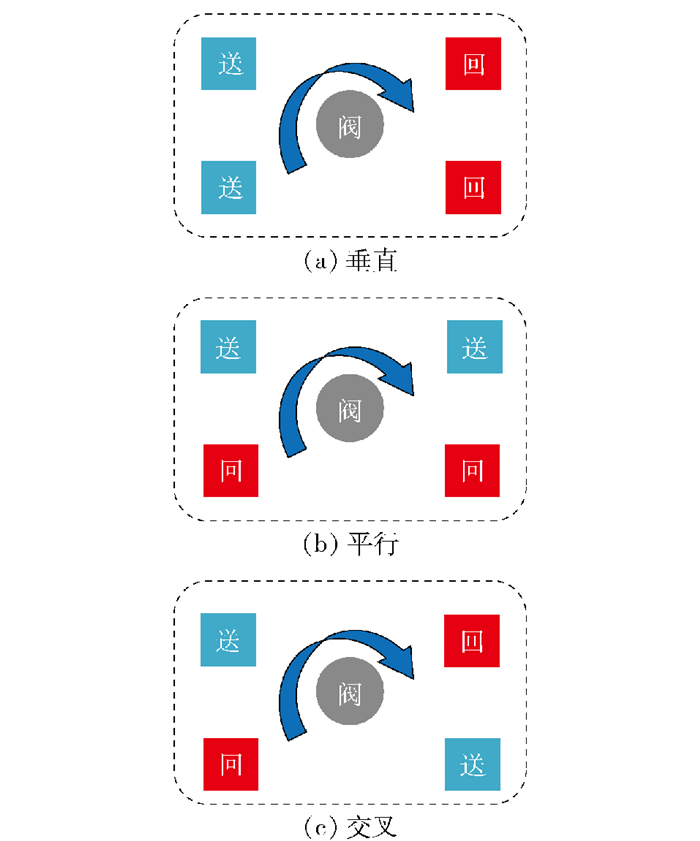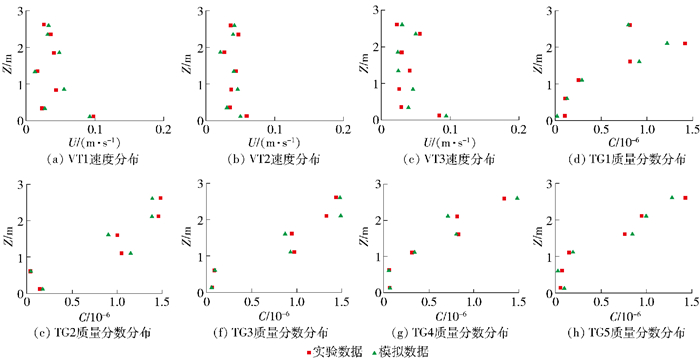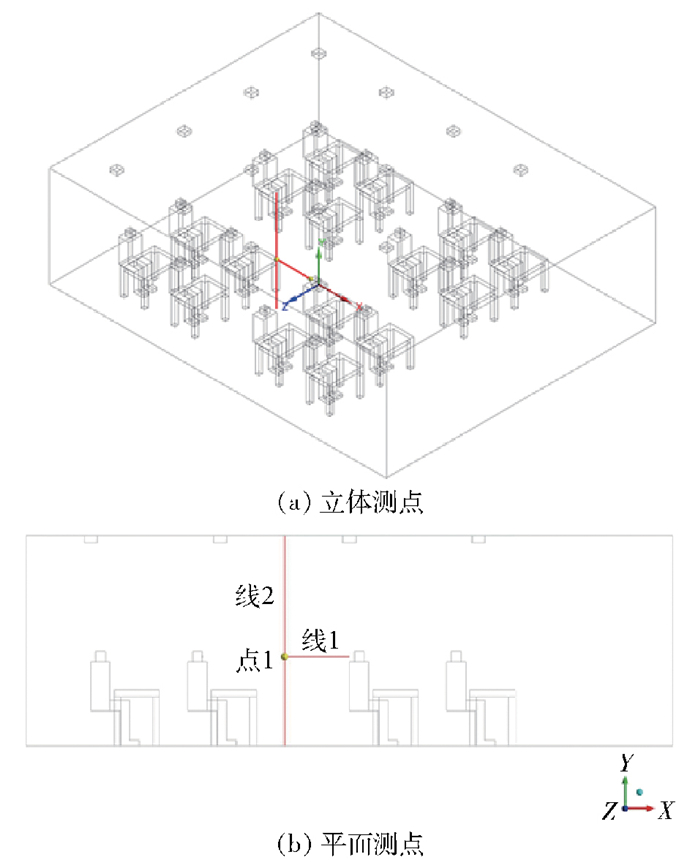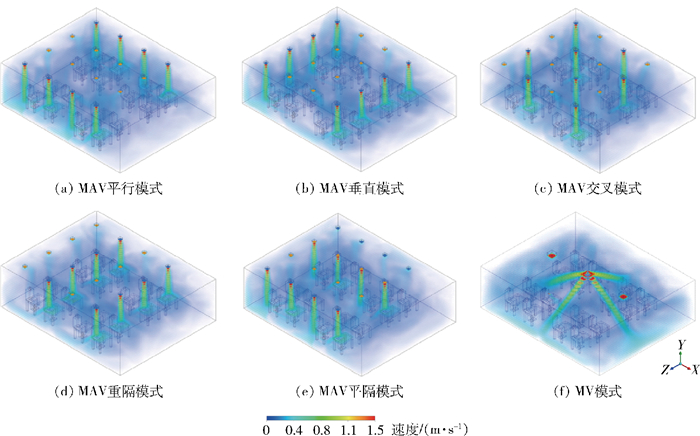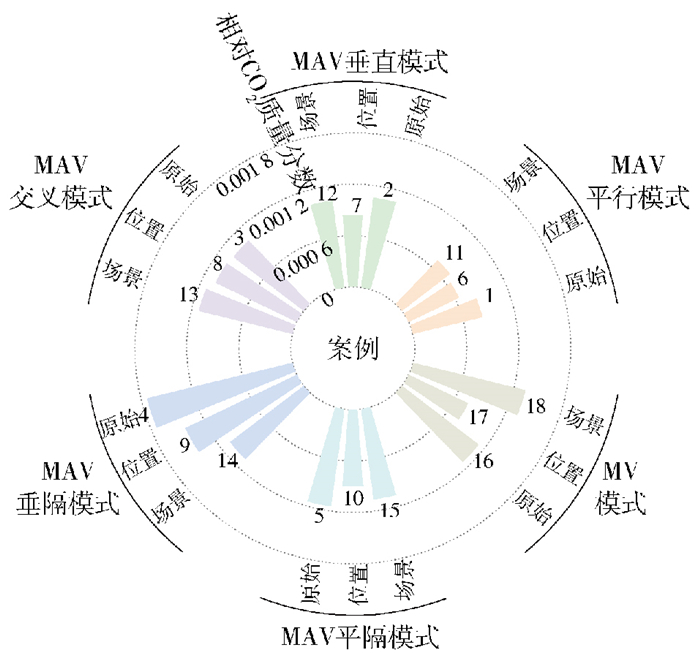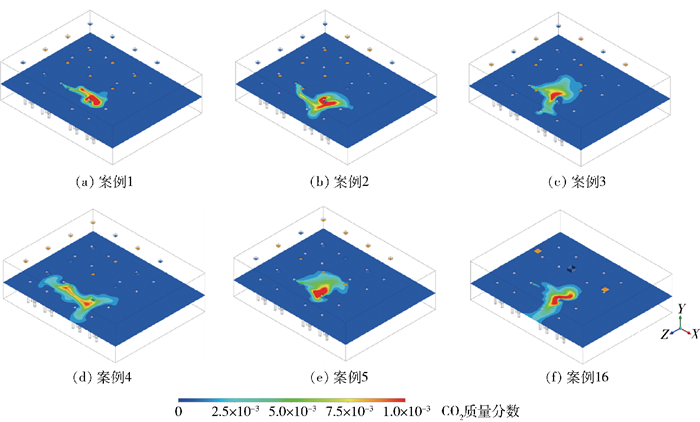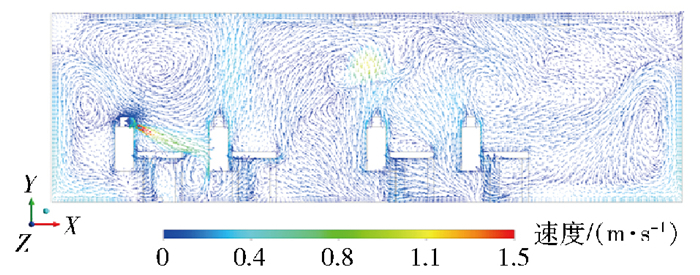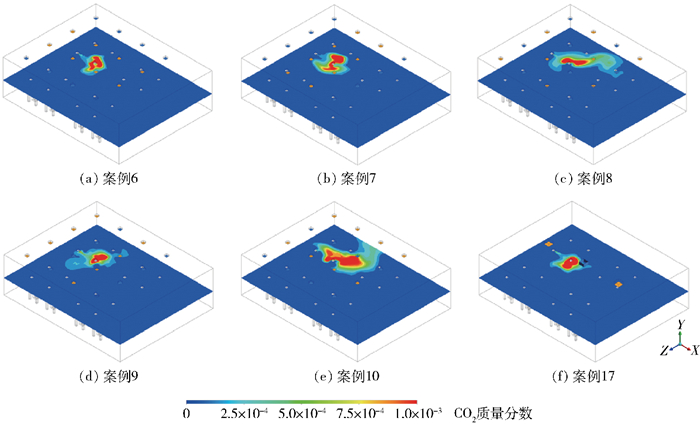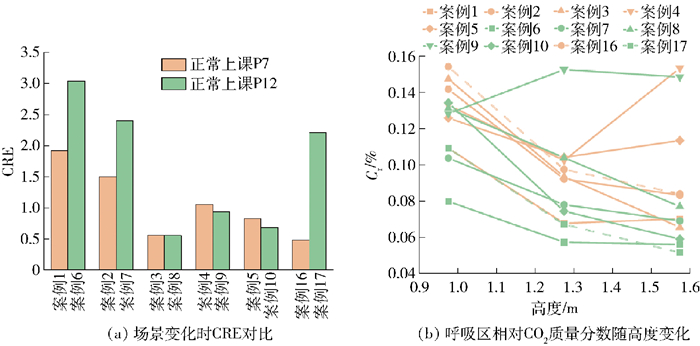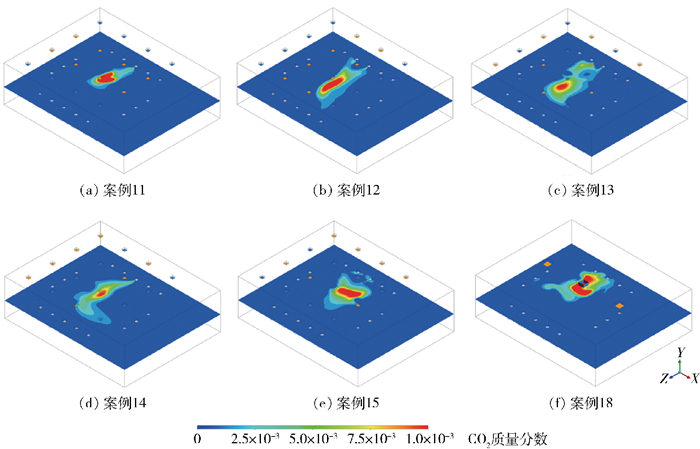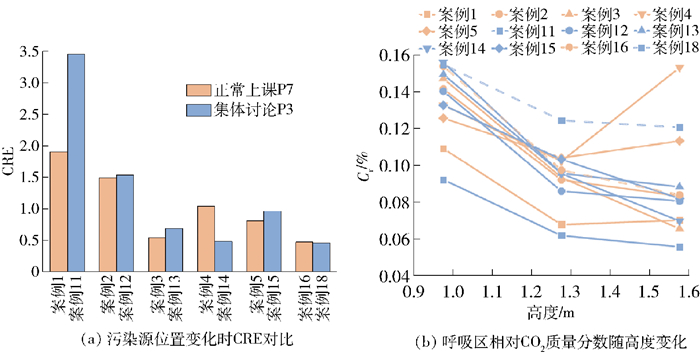Study of Pollutant Dispersion Control Performance of Multi-module Adaptive Ventilation —an Example of Coping With Changes in Classroom Usage Scenarios
-
摘要:
提出了一种多模块适应性通风(multi-module adaptive ventilation, MAV)方法, 同时研究其在多场景类型建筑中面对室内场景变化和污染源位置变化时, 控制污染物扩散和排除污染物的性能。以一教室为模型, 利用计算流体动力学(computational fluid dynamics, CFD)技术模拟教室正常上课和集体讨论场景下的污染物分布情况, 并在正常上课场景下进行污染源位置变化的讨论。其中示踪气体CO2用于模拟感染者咳嗽产生的污染物。选用了5种不同的MAV模式和传统混合通风(mixing ventilation, MV)模式, 比较了它们在面对教室内不同污染源位置和不同场景时, 人员呼吸区的污染物浓度和去除率。结果表明合适的MAV模式下污染物在呼吸区的相对浓度更低、排除率更高, 其中MAV平行模式在集体讨论场景下、污染源位置为P3时的呼吸区污染物去除率(contaminant removal efficiency, CRE)是MV模式的7.52倍, 呼吸区相对污染物质量浓度Cr为MV模式的52.4%, 说明合适的MAV模式能更好地适应场景和污染源位置的变化。
Abstract:A type of ventilation method, multi-module adaptive ventilation, hereinafter referred to as MAV, is proposed. At the same time, it studies to control the diffusion of pollutants in classroom buildings when facing with changes in indoor scenes and changes in the location of pollution sources and the ability to remove contaminants. Computational fluid dynamics technology was used to simulate the distribution of pollutants in the classroom in normal class and group discussion scenarios, and to change the location of pollution sources in the normal class scenario. The tracer gas (CO2) was used to simulate the pollutants produced by the cough of an infected person. Five different MAV modes and conventional mixed ventilation (MV) modes were selected to compare their pollutant concentrations and removal rates in the respiratory zone of personnel in the face of different pollutant source locations and different scenarios in the classroom. Results show that the relative concentration of pollutants in the breathing zone is lower and the exclusion rate is higher with the appropriate MAV mode, in which the pollutant removal rate (CRE) in the breathing zone of the MAV parallel mode is 7.52 times that of the MV mode in the group discussion scenario and the location of the pollutant source is P3, and the relative pollutant concentration Cr in the breathing zone is 52.4% of that in the MV mode, indicating that the appropriate MAV mode can better adapt to the scenario and the change of pollutant source location.
-
呼吸道传染性疾病严重危害了人们的身体健康,如2003年爆发的SARS,2019年爆发的新型冠状病毒感染等对人们的生产和生活造成了重大影响。大部分呼吸道传染性疾病以含有病毒或细菌的飞沫颗粒为传播介质,患者通过呼吸、咳嗽、喷嚏等方式将病菌传播给健康人群[1]。教室作为人员密集聚集地,其内部人员面临着巨大的交叉感染风险。为了降低教室内部人员交叉感染的风险,应改善建筑通风系统的设计结构,通过合理的气流组织,降低病菌在空气中的传播风险。
混合通风是教室内最为常见的一种通风方式,新风与室内的污浊空气混合,污染物充斥整个房间,虽然浓度得到稀释,可容易造成交叉感染[2]。为了解决混合通风在污染物去除方面的缺陷,后续人们又提出了多种新的通风方式。个性化通风虽然可以很好改善人体呼吸区域的污染物浓度[3],但是对于教室来说其成本太过高昂,且对建筑已有通风系统结构的完全改造实施起来有着巨大的困难。置换通风虽然能实现热力分层[4],保证人体呼吸区域的空气洁净度,但是其会造成头热脚冷的不舒适感[5]。其对建筑层高要求较高,并且受到室内热源分布、人员活动等因素的扰动巨大,对于教室而言其对污染物的控制效果并不理想。
这几种通风方式在面对室内场景变化和污染源位置变化时,并不能根据当下状况及时调整。对于教室这类内部人员活动频繁且室内场景多样化的建筑来说,有必要考虑当室内场景发生变化或污染源位置发生变化时,原有的通风方式是否仍然能满足当下的需求。Shao等[6]提出了一种多模通风(multi-mode ventilation, MMV)方式,其由多个单一气流模式组合而成,通过开启、关闭风口可以适应特定的几个场景变化。但面对多变场景时无能为力,且这种方法造成了风口利用率严重低下,引起风口末端冗余。
为了满足场景和污染源位置变化时人们对室内环境的需求,本文提出了一种可变适应性通风方式——多模块适应性通风(multi-module adaptive ventilation,MAV)[7-8]。
MAV基于模块化设计,每4个风口及相应风管为一个模块,每个模块是2个送风口和2个回风口的搭配,通过中央风阀可以进行风口之间的送、回风切换。在面对不同室内需求时,其可以通过风口功能的转换实现不同的通风方式,以此来适应室内场景和污染源位置的变化,满足污染物去除的需求。
1. 研究方法
1.1 MAV概述
MAV是一种基于模块化的可变通风方式,旨在减少室内空间的污染物扩散并提高污染物排除率。在传统的中压送风系统中,顶部散流器通常采用倾斜射流,增加了室内空气混合程度,满足了人体的热舒适需求,但不利于控制污染物的扩散。MAV采用垂直低速送风对室内流场进行区域性分隔,MAV的风口位置固定,但通过中央风阀的旋转可以实现任意风口的送、回风功能切换,以提供不同的室内通风模式。图 1(a)展示了MAV中央风阀的结构和原理。新风通过送风干管进入送风区,通过可变风口送入室内。室内空气通过可变风口进入回风区并经回风干管回收处理。图 1(b)为MAV系统示意图,展示了标准教室场景下的MAV布置情况,此场景下共布置了4个MAV模块,每个模块单独控制,其中每个模块包含4个风口,可变风口可以进行送、回风的功能切换,每个模块始终保持两送两回的状态。图 2展示了单个MAV模块的切换方法及策略,每个通风模块都有单独的3种切换策略,分别为平行、垂直和交叉模式,通过风阀内的转子旋转可以实现风口功能的切换,转子的隔板将风阀箱体内部分隔为送风区和回风区,通过箱体内的电机和传动齿轮带动转子转动并控制其转动角度,使其和风口对应,送风区和回风区对应的风道随之改变,这样实现了风口的功能性转变。室内布置多个模块则可以实现多种不同的通风策略,MAV可以根据房间的大小、功能对通风模块的数量及布置进行调整,以满足不同的通风需求。
1.2 CFD模型验证
在本研究中,使用流体模拟软件Fluent进行模型验证和数值分析,利用Yin等[9]的实验数据验证模拟的准确性。图 3(a)展示了实验的场景和布置,在一个全尺寸的单人病房(4.90 m×4.32 m×2.72 m)有1名病人、1名医护人员、1张床、1台电视机和1台医疗设备,新鲜空气由近地面扩散器供应,房间里有2个排风口,1个主排风,1个辅助排风。研究的通气速率为4 ACH (0.057 m3/s),辅助排风从病房抽取0.039 m3/s的空气到卫生间,其余由主排风抽取,系统的送风温度均为19.5 ℃。其中病人、医护人员、电视和医疗设备的热负荷分别为106.3、110.6、23.8和36.3 W。SF6被用作示踪气体,为了模拟咳嗽引起的疾病病毒,使用了1台“咳嗽机”,它有1个风扇,将室内空气与SF6气体或颗粒混合,咳嗽机的出口速度为2.9 m/s。虽然该研究的建筑主体是病房,但是其研究内容是室内病患呼出污染物的分布,与本文研究是同一个方向,且采用了示踪气体,两者边界条件较为相似,同时该实验研究的边界条件较为完善,为模拟验证提供了良好的基础。故本文研究选用了该“单人病房”的实验来进行CFD方法的模型及数值方法验证。
验证使用了120万网格单元数量的模型,对风口处网格附近进行加密处理。选择RNG k-ε模型进行求解,近壁面处湍流运动选择标准壁面函数(stand wall function, SWF)进行模拟,控制方程中的对流项和扩散项使用二阶迎风方案进行离散化。采用组分输运模型用于计算空气中污染物的浓度,其中空气密度被视为常数。风口和人体口部外的其他表面均设为壁面,温度条件与实验一致,送风口设置为速度入口,排风口设置为压力出口。
图 3(b)展示了实验的测点位置,设置了3个风速测量点和5个示踪气体浓度测量点,分别命名为VT1~VT3和TG1~TG5。空气速度测量是分别在距离地面0.12、0.35、0.85、1.35、1.85、2.35和2.60 m的7个高度上进行的。对于示踪气体,测量是分别在距离地面0.12、0.60、1.10、1.60、2.10和2.60 m的6个高度进行的。图 4展示了实验和CFD模拟中速度和SF6浓度的垂直分布,其中速度分布是给定通风模式和边界条件下流场的稳态计算,SF6浓度分布是感染者在稳定流场中咳嗽时污染物扩散的瞬态计算。与实测结果相比,CFD模拟的速度和示踪气体浓度平均相对误差分别为-1.9%、2.2%,至此验证了CFD计算的准确性,CFD模型可以用来预测气流场和浓度场。
1.3 物理模型构建
在本研究中,选取了一个16人的典型教室作为模型,分别设定了正常上课和集体讨论2种场景。如图 5所示,教室长10.0 m,宽8.0 m,高3.0 m。16名人员被设置为热源。每张桌子的高度为0.8 m,长度为1.0 m,宽度为0.7 m。人员被简化为16个坐姿的人体模特,每个模特的口部高度为1.275 m,呼吸区是人体口部半径0.3 m以内的区域,所以本次呼吸区范围取地面以上0.975~1.575 m。正常上课场景下患病人员分别设置为P7和P12,集体讨论场景下患病人员位置设置为P3,这几处位置处人员分布最为密集,且这2个位置的咳嗽射流的影响范围也最广。对于MAV通风系统,天花板上共有16个通风口:8个用于供气,8个用于排风。每个通风口的尺寸为0.2 m×0.2 m。共采取5种典型的MAV风口控制策略,同时设置一组传MV通风方式,如图 6所示。
1.4 数学模型描述
利用Fluent模拟时对数学模型进行如下假设:
1) 教室内气密性良好,不考虑教室的渗透风量;
2) 污染源仅由人口部释放,无其他来源;
3) 室内空气为常温、低速、常物性、不可压缩的牛顿流体湍流流动。
教室气流为湍流流动,选择RNG k-ε模型进行求解,近壁面处湍流运动选择标准壁面函数进行模拟,控制方程中的对流项和扩散项使用二阶迎风方案进行离散化。采用组分输运模型用于计算空气中污染物的浓度,其中空气密度被视为常数。
数学模型利用SIMPLE算法求解稳态的连续相流场,得到稳定的温湿度流场后,再加入咳嗽扰动模型并采用PISO算法进行瞬态计算,时间步长设置为0.1 s,模拟污染物0~40 s的扩散情况,得到污染物扩散40 s后的分布状态,此时室内空气污染物的浓度及范围基本趋于稳定。
1.5 性能评估
污染物去除率(contaminant removal efficiency, CRE)[10]用于评价系统去除呼吸区污染物的性能。CRE主要取决于气流状态、污染源的强度和位置。CRE越小,除污效果越差[11]。CRE的表达式为
$$\mathrm{CRE}=\frac{C_{\mathrm{e}}-C_{\mathrm{s}}}{\bar{C}_{\mathrm{b}}-C_{\mathrm{s}}}$$ (1) 式中Ce、Cs、Cb分别为排风口、供气口的污染物质量分数和呼吸区(人体口部半径0.3 m以内的区域)的平均污染物质量分数,%。
相对污染物质量分数Cr是某一体积内的污染物质量分数与源头质量分数的比,用于评价污染物的扩散程度,计算方法为
$$C_{\mathrm{r}}=\frac{\bar{C}_{\mathrm{b}}}{C_{\mathrm{ex}}}$$ (2) 式中Cex是呼出气流中的污染物质量分数,%。
1.6 边界条件和案例设置
Gupta等[12]通过实验和回归分析详细研究了咳嗽的特征,开口面积为4.3 cm2,咳嗽射流的角度约为水平以下30°,本研究采用该数据。咳嗽的喷射速度为脉冲函数,这里把单次咳嗽视为一次脉冲波动[13]。图 7展示了本研究采用的咳嗽模型,射流初速度设为9 m/s,射流角度与水平线夹角为30°。
人类咳嗽产生的飞沫核中,97%的直径在0.5~2.0 μ m以内[13]。这些飞沫可以长时间保持在空气中,其运输模式与气体非常相似,粒径较小,能长时间在空气中悬浮,并易随气流运动的颗粒,可以考虑采用释放示踪气体来替代[14]。CO2和SF6都是常用的示踪气体,诸多研究表明两者均可以较好地预测室内污染物的传递和分布,Men等[15]用示踪气体法测量建筑物渗透速率的实验研究表明,作为示踪气体的CO2和SF6之间的空气变化率偏差在-9.0%~7.4%。这证实了CO2方法是一种有效的技术,用其替换SF6进行示踪误差在可接受范围内,是可行的。且本研究的CO2背景浓度设定为零,不存在空气中原本含有的CO2干扰问题。SF6测量需要昂贵的大型设备,且自身是有毒有害气体,对人体的健康和安全存在隐患。为了后续的研究和实验的顺利开展,本研究选择了CO2作为示踪气体。咳嗽射流中CO2的初始质量分数设置为0.06,接近呼出流中CO2的质量分数[16],表 1列出边界条件的详细设置。表 2列出了本次模拟设置的18个案例,将它们分为3组,其中案例1~5以及案例16作为一组初始状态,案例1~5采用了MAV的5种典型的风口控制策略,案例16则采用MV系统进行对比研究。案例6~10以及案例17污染源位置发生了变化,和初始状态组进行对比,探究MAV对污染源位置变化的适应能力。案例11~15以及案例18室内场景发生了变化,和初始状态组进行对比,探究MAV对室内场景变化的适应能力。
表 1 边界条件Table 1. Boundary conditions表面 边界条件 桌子、墙壁、地面、天花板 壁面,绝热 人员 壁面,热通量40 W/m2 口 速度入口,咳嗽速度9 m/s, 温度34 ℃,CO2质量分数0.06 送风口 速度入口,出流速度1.5 m/s, 温度20 ℃ 回风口 压力出口,0 Pa 表 2 案例设置Table 2. Case setting案例 室内场景 风口控制策略 污染源位置 1 正常上课 MAV平行模式 P7 2 正常上课 MAV垂直模式 P7 3 正常上课 MAV交叉模式 P7 4 正常上课 MAV垂隔模式 P7 5 正常上课 MAV平隔模式 P7 6 正常上课 MAV平行模式 P12 7 正常上课 MAV垂直模式 P12 8 正常上课 MAV交叉模式 P12 9 正常上课 MAV垂隔模式 P12 10 正常上课 MAV平隔模式 P12 11 集体讨论 MAV平行模式 P3 12 集体讨论 MAV垂直模式 P3 13 集体讨论 MAV交叉模式 P3 14 集体讨论 MAV垂隔模式 P3 15 集体讨论 MAV平隔模式 P3 16 正常上课 MV模式 P7 17 正常上课 MV模式 P12 18 集体讨论 MV模式 P3 1.7 网格独立性验证
在本次研究中使用多边形网格对整个教室进行网格划分[17],其中作为病患人员的口和各个风口分别进行网格加密。以教室内正常上课场景下,P7为病患,采用MAV平行模式时为例生成3种不同数量的网格,分别是90万、120万、150万网格单元,以此来确定本次模拟所需的最低网格数,直到流场的解和网格无关[18]。图 8展示了本次验证的测量位置线1、线2、点1。图 9展示了本次测量的参量及3种不同数量网格下的数据对比。由图 9可知3种不同数量网格下,线1和线2上的速度分布差距十分微小。点1上CO2的质量分数随着时间的变化曲线误差也在允许范围内。因此,验证了网格的独立性。本次模拟取网格数量120万,其中嘴的网格尺寸设置为0.000 75 m,风口上的网格尺寸设置为0.007 5 m,房间内其他区域网格尺寸设置为0.015~0.075 m。
2. 结果及讨论
2.1 气流组织分析
以案例1为例分析MAV的气流形式,教室内正常上课场景下,16名室内人员均匀分布,占据了教室内的绝大部分空间。图 10为正常上课场景下,使用MV和5种MAV通风模式的室内气流速度分布图,具体控制方案及风口排布见图 6。图 10(a)~(e)展示MAV采用低速垂直射流的方式送风,射流在水平方向仅产生了微小的扩散,并进入人体的呼吸区域,气流达到地面后沿着地面扩散开来。但是由于桌子和人体等障碍物的存在,一部分垂直射流会在到达桌面后,开始在桌面高度水平扩散。图 10(f)展示MV是通过教室顶部的散流器,将空气扩散到房间中。当人员咳嗽时,污染物会随着射流向水平方向扩散,遇到桌子、人体等障碍物时进一步向四周扩散。如图 11(a)所示,MV的送风气流有很大的水平分速度,同时可以看出MV模式呼吸区范围内的气流高度混合,空气循环范围更大,不利于污染物扩散的控制。如图 11(b)所示,MAV垂直射流送风,流线整体呈竖直趋势,且呼吸区水平气流较少,这利于控制污染物的水平扩散。
2.2 咳嗽污染物的扩散分析
2.2.1 MAV控制污染物扩散的特性分析
图 12展示了本次研究中18个案例对于污染物的控制性能,将18个案例按照原始状态、污染源位置变化、场景变化分为3组,每组包含6个案例分别应用6种通风模式,比较6种通风模式在污染源位置变化、场景变化时的呼吸区相对污染物浓度状态,来说明6种通风模式对污染物的控制效果,呼吸区相对污染物浓度越低说明通风系统控制污染物扩散的性能越强。以案例1~5和案例16为例,取污染物从开始扩散到40 s时的浓度分布,此时空气中污染物的浓度和扩散面积已经基本趋于稳定。
图 13展示了案例1~5和案例16,正常上课场景污染源位置在P7,分别使用MV通风模式和MAV通风模式时,室内污染物扩散情况和浓度分布。图 13(a)案例1,MAV平行模式的控制效果最为优良,P7咳嗽射流方向与MAV平行模式的风口排列平行,恰好位于回风区域,而两侧全是送风区域,保证了污染物始终不会向Z方向上大面积水平扩散,其扩散范围被牢牢控制在Z向很小的范围内,而X向上污染物在扩散过程中受到了其扩散路径上回风口的气流作用,使得其在X向上的最大扩散范围保持在该回风口附近。图 13(b)案例2,MAV垂直模式下P7咳嗽射流与MAV垂直模式的风口排列垂直,所以污染物在水平Z方向没有受到送风口的限制,导致了MAV垂直模式在水平Z向上的控制效果要差于MAV平行模式。图 13(c)案例3,MAV交叉模式属于交叉型的风口排布,类似于MV,但是MAV的垂直低速送风无水平分速度,使得MAV交叉模式对人体呼吸区高度污染物的控制效果整体上仍然优于MV。图 13(d)案例4的MAV垂隔模式和图 13(e)案例5的MAV平隔模式送、回风口间隔排列,MAV的垂直低速送风产生的截断气流会引起局部气流分区,但MAV垂隔模式下的送风口距离过远,导致其在水平方向上对污染物的控制效果并不理想。图 13(f)案例16,MV模式下P7在送风口和回风口之间Z正向位置,咳嗽发生时,咳嗽射流在极短时间内,以极快的初始速度斜向下喷射出来,这个阶段污染物的扩散受气流组织的影响较小,此后由于障碍物桌子的作用,大部分气流首先撞击在桌面上并开始逐渐扩散开来,进入咳嗽射流的污染物扩散阶段。同时,P7产生的污染物在扩散阶段,受到MV送风口散流器在Z正方向的巨大干扰,导致污染物向Z正向密集扩散,甚至有超出壁面的趋势,这也导致该位置的几位同学附近的污染物并没有得到很好的控制,被人吸入体内。
2.2.2 污染源位置变化情况下MAV的适应性验证
当污染源位置从P7变为P12时,对比图 12中案例1~5和案例6~10及案例16和案例17的呼吸区相对CO2质量分数可知,MAV平行模式受到污染源位置变化的影响最小,控制污染物扩散的性能优异。而MV模式下案例17的控制效果远好于案例16,面对污染源位置变化时,MV模式的控制效果几乎只取决于污染源自身,适应能力较差。
图 14展示了案例6~10及案例17,正常上课场景下污染源位置变化为P12时分别使用MV通风模式和MAV通风模式时室内污染物的扩散情况。对比图 13(f),图 14(f) MV对污染物的控制效果要远比污染源为P7时好。图 15展示了P12处纵截面气流分布,P12和前方人员距离较近,咳嗽射流受到了前方人员身体的阻挡,同时又因为和后面墙壁贴合较近,室内气流在P12附近形成了2个涡流区域,污染物基本被控制在涡流区域内,同时该处涡流通过循环直接进入了出风口,并带走了污染物。结合图 13(f),MV这类单一气流模式,在面对污染源位置变化时,其控制效果几乎完全取决于污染源自身,不能适应污染源位置的变化。图 14(a)案例6,MAV平行模式下污染物被控制在一个很小的范围内,扩散面积比污染源在P7位置时更小。图 14(b)案例7,MAV垂直模式也将污染物扩散范围控制在一个很小的区域,没有出现明显的污染物水平传播。图 14(c)~(e),3种MAV模式风口存在间隔排列,垂直射流分区变大,导致污染物的控制效果并不理想。对比图 13(a)~(e)所展示的5种MAV通风模式的控制效果,当污染源位置变化时,整体而言MAV平行模式和MAV垂直模式对污染物的控制效果均良好,适应性较强。
图 16(a)对比了正常上课场景下污染源位置变化时人体呼吸区的CRE数值,MAV模式下的案例1、2、6、7的CRE均保持在较高水平,案例6和案例7的CRE水平分别是案例1和案例2的1.59倍和1.60倍。MV模式下的案例16和案例17的CRE水平表现出了巨大差异,案例17的CRE水平为案例16的4.60倍,说明污染源位置变化时MAV模式CRE受到的影响相较MV模式更小。同时案例1和案例6的CRE水平分别是案例16和案例17的3.98倍和1.38倍,说明MAV模式的污染物去除能力相较MV模式更强。MV模式的CRE几乎只取决于污染物自身,而MAV可以通过切换不同的气流模式来保持高水平的CRE,使得室内空气环境清新。
图 16(b)对比了正常上课场景下污染源位置由P7变化到P12时人体呼吸区范围内相对污染物质量分数Cr的分布情况。MAV模式下的案例1、2、6、7的呼吸区相对污染物浓度均保持在低水平,污染源位置变化对MAV模式下呼吸区污染物浓度分布影响较小,MV模式下案例16的污染物浓度分布在高水平,对比案例17差异大,同时案例1和案例6的Cr分别是案例16和案例17的73.4%和84.7%,说明MAV模式相较MV模式控制污染物扩散的能力更强。
2.2.3 场景变化情况下MAV的适应性验证
室内场景从正常上课变为集体讨论时,对比图 12中案例1~5和案例11~15及案例16和案例18的呼吸区相对CO2质量分数可知,MAV平行模式受到场景变化的影响最小,控制污染物扩散的性能优异。而MV模式下案例16和案例18,面对场景变化时,MV模式控制污染物扩散的性能低下,对场景变化的适应能力较差。
集体讨论场景下,教室人员围坐一周。图 17展示了案例11~15及案例18室内污染物的扩散情况。案例11 MAV平行模式下咳嗽产生的污染物受到隔断气流的作用,被控制在了一个较小的范围内。案例12 MAV垂直模式在X方向上的扩散距离略大于MAV平行模式。案例13~15污染物的扩散范围相近,均没有达到良好的效果。案例18 MV模式下咳嗽射流首先沿Z向传播,随后受到顶部散流器沿X方向射流的作用,在Z向上的传播被隔断,但是携带咳嗽污染物的空气流沿着X向传播到了P7所在位置的横排人员,造成了污染物的传播。图 17和图 15对比展示,面对室内场景的变化,MV模式适应性差,对污染物的扩散控制性能低下。MAV模式中的平行模式和垂直模式对场景变化的适应性较强,控制污染物的性能优异,尤其MAV平行模式适应能力最强。
图 18(a)展示了正常上课场景和集体讨论场景的人体呼吸区CRE对比数值,MAV模式下的案例1、2、11、12的CRE均保持在较高水平,案例11和案例12的CRE水平分别是案例1和案例2的1.81倍和1.03倍,MV模式下的案例16和案例18的CRE水平低下,场景变化时MAV模式的CRE受到的影响较小。同时案例1和案例11的CRE水平分别是案例16和案例18的3.98倍和7.52倍,进一步证明了MAV模式的污染物去除能力相较MV模式更强。
图 18(b)对比了正常上课场景和集体讨论场景的人体呼吸区范围内Cr的分布情况,MAV模式下的案例1、2、11、12的呼吸区Cr均保持在低水平,场景变化对MAV模式下呼吸区污染物扩散影响较小。MV模式下案例16和案例18的呼吸区污染物浓度高、差异大,对场景变化的适应能力弱。同时案例1和案例11的Cr分别是案例16和案例18的73.4%和52.4%,说明MAV模式相较MV模式控制污染物扩散的能力更强。
3. 结论
在本研究中,提出了一种适应性通风方法MAV。MAV基于模块化设计,4个风口为一个模块,可以根据室内场景和污染源位置的变化切换风口的功能进而改变通风方案,且不需要改变风口的位置。为研究MAV面对教室内场景变化和污染源位置变化时,控制污染物扩散和排除污染物的性能,利用计算机流体力学技术进行数值模拟,得出以下结论:
1) 传统MV在面对室内场景变化和污染源位置变化时,其对污染物扩散范围的控制和污染物排出率均较低,对此类动态变化的适应能力弱。
2) MAV在面对污染源位置变化和教室内部场景变化时,通过调整MAV模式,能够很好地适应动态变化,表现出优良的污染物控制能力和污染物排除效果。
3) MAV平行模式和MAV垂直模式面对室内场景变化及污染源位置变化时,普适性较强,整体上表现出较好污染物控制和排除性能力,尤以MAV平行模式适应性最强。
4) 在面对教室初始状态、污染源位置变化、室内场景变化时,MAV平行模式的呼吸区污染物去除率分别是MV模式的3.98倍、1.38倍和7.52倍,呼吸区相对污染物质量分数Cr分别为MV模式的73.4%、84.7%和52.4%,说明合适的MAV模式能更好地适应场景和污染源位置的变化。
5) MAV系统在工程设计时,需要考虑室内常见的场景变化和人员排布,以此来对MAV模块进行分区域安装,合理的MAV模块设置才能使MAV系统发挥更大作用。
-
表 1 边界条件
Table 1 Boundary conditions
表面 边界条件 桌子、墙壁、地面、天花板 壁面,绝热 人员 壁面,热通量40 W/m2 口 速度入口,咳嗽速度9 m/s, 温度34 ℃,CO2质量分数0.06 送风口 速度入口,出流速度1.5 m/s, 温度20 ℃ 回风口 压力出口,0 Pa 表 2 案例设置
Table 2 Case setting
案例 室内场景 风口控制策略 污染源位置 1 正常上课 MAV平行模式 P7 2 正常上课 MAV垂直模式 P7 3 正常上课 MAV交叉模式 P7 4 正常上课 MAV垂隔模式 P7 5 正常上课 MAV平隔模式 P7 6 正常上课 MAV平行模式 P12 7 正常上课 MAV垂直模式 P12 8 正常上课 MAV交叉模式 P12 9 正常上课 MAV垂隔模式 P12 10 正常上课 MAV平隔模式 P12 11 集体讨论 MAV平行模式 P3 12 集体讨论 MAV垂直模式 P3 13 集体讨论 MAV交叉模式 P3 14 集体讨论 MAV垂隔模式 P3 15 集体讨论 MAV平隔模式 P3 16 正常上课 MV模式 P7 17 正常上课 MV模式 P12 18 集体讨论 MV模式 P3 -
[1] BERLANGA F A, OLMEDO I, RUIZ DE ADANA M. Experimental analysis of the air velocity and contaminant dispersion of human exhalation flows[J]. Indoor Air, 2017, 27(4): 803-815. doi: 10.1111/ina.12357
[2] LIU M X, LIU J J, CAO Q, et al. Evaluation of different air distribution systems in a commercial airliner cabin in terms of comfort and COVID-19 infection risk[J]. Building and Environment, 2022, 208: 108590. doi: 10.1016/j.buildenv.2021.108590
[3] EUSÉBIO C, HAZIM A. Evaluation of integral effect of thermal comfort, air quality and draught risk for desks equipped with personalized ventilation systems[J]. Energies, 2021, 14(11): 3235. doi: 10.3390/en14113235
[4] LIU M X, CHANG D, LIU J J, et al. Experimental investigation of air distribution in an airliner cabin mockup with displacement ventilation[J]. Building and Environment, 2021, 191: 107577. doi: 10.1016/j.buildenv.2020.107577
[5] LASTOVETS N, KAI S R, KOSONEN R, et al. Dynamic performance of displacement ventilation in a lecture hall[J]. International Journal of Ventilation, 2021, 20(3/4): 204-214.
[6] SHAO X L, LI X T, MA X J, et al. Multi-mode ventilation: an efficient ventilation strategy for changeable scenarios and energy saving[J]. Building and Environment, 2017, 115: 332-344. doi: 10.1016/j.buildenv.2017.01.032
[7] ZHANG H T, ZHANG W R, ZHANG W J, et al. Multi-vent module-based adaptive ventilation to reduce cross-contamination among indoor occupants[J]. Building and Environment, 2022, 212: 108836. doi: 10.1016/j.buildenv.2022.108836
[8] ZHANG W J, ZHANG W R, ZHANG H T, et al. Effective improvement of a local thermal environment using multi-vent module-based adaptive ventilation[J]. Building Simulation, 2023, 16(7): 1115-1134. doi: 10.1007/s12273-023-0992-6
[9] YIN Y G, GUPTA J K, ZHANG X S, et al. Distributions of respiratory contaminants from a patient with different postures and exhaling modes in a single-bed inpatient room[J]. Building and Environment, 2011, 46(1): 75-81. doi: 10.1016/j.buildenv.2010.07.003
[10] ZHANG W J, ZHANG W R, MIZUTANI K, et al. Decision-making analysis of ventilation strategies under complex situations: a numerical study[J]. Building and Environment, 2021, 206: 108217. doi: 10.1016/j.buildenv.2021.108217
[11] CHENG Z, AGANOVIC A, CAO G Y, et al. Experimental and simulated evaluations of airborne contaminant exposure in a room with a modified localized laminar airflow system[J]. Environmental Science and Pollution Research, 2021, 28(24): 30642-30663. doi: 10.1007/s11356-021-12685-4
[12] GUPTA J K, LIN C H, CHEN Q. Flow dynamics and characterization of a cough[J]. Indoor Air, 2009, 19(6): 517-525. doi: 10.1111/j.1600-0668.2009.00619.x
[13] DUGUID J P. The size and the duration of air-carriage of respiratory droplets and droplet-nuclei[J]. Journal of Hygiene, 1946, 44(6): 471-479.
[14] SINGER B C, ZHAO H, PREBLE C V, et al. Measured influence of overhead HVAC on exposure to airborne contaminants from simulated speaking in a meeting and a classroom[J]. Indoor Air, 2022, 32(1): e12917.
[15] MEN C L, WANG S W, ZOU Z J. Experimental study on tracer gas method for building infiltration rate measurement[J]. Building Services Engineering Research and Technology, 2020, 41(6): 745-757. doi: 10.1177/0143624420911810
[16] RUDNICK S N, MILTON D K. Risk of indoor airborne infection transmission estimated from carbon dioxide concentration[J]. Indoor Air, 2003, 13(3): 237-245. doi: 10.1034/j.1600-0668.2003.00189.x
[17] LIU Y, LONG Z W, LIU W. A semi-empirical mesh strategy for CFD simulation of indoor airflow[J]. Indoor and Built Environment, 2022, 31(9): 2240-2256. doi: 10.1177/1420326X221089825
[18] XU X H, LI H, LIN Y F. Mesh-order independence in CFD simulation[J]. IEEE Access, 2019, 7: 119069-119081. doi: 10.1109/ACCESS.2019.2937450



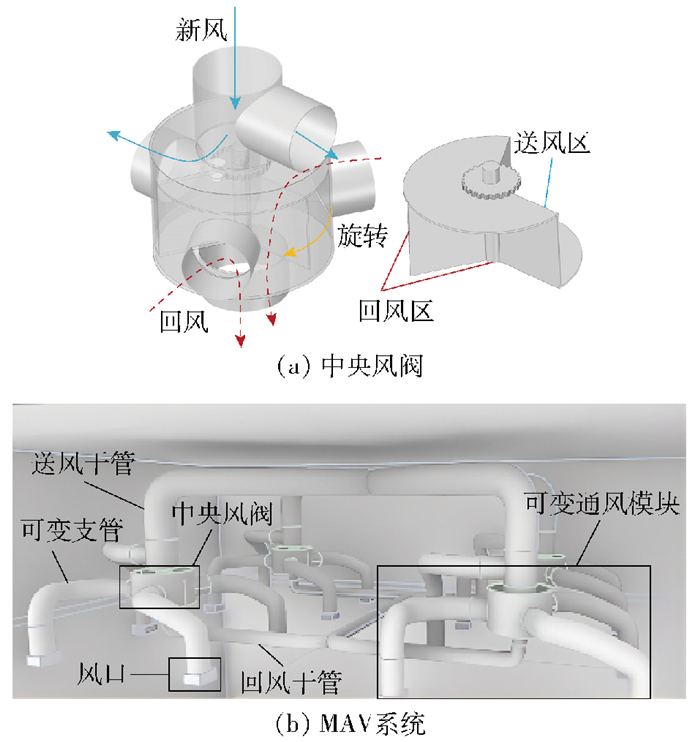
 下载:
下载:
